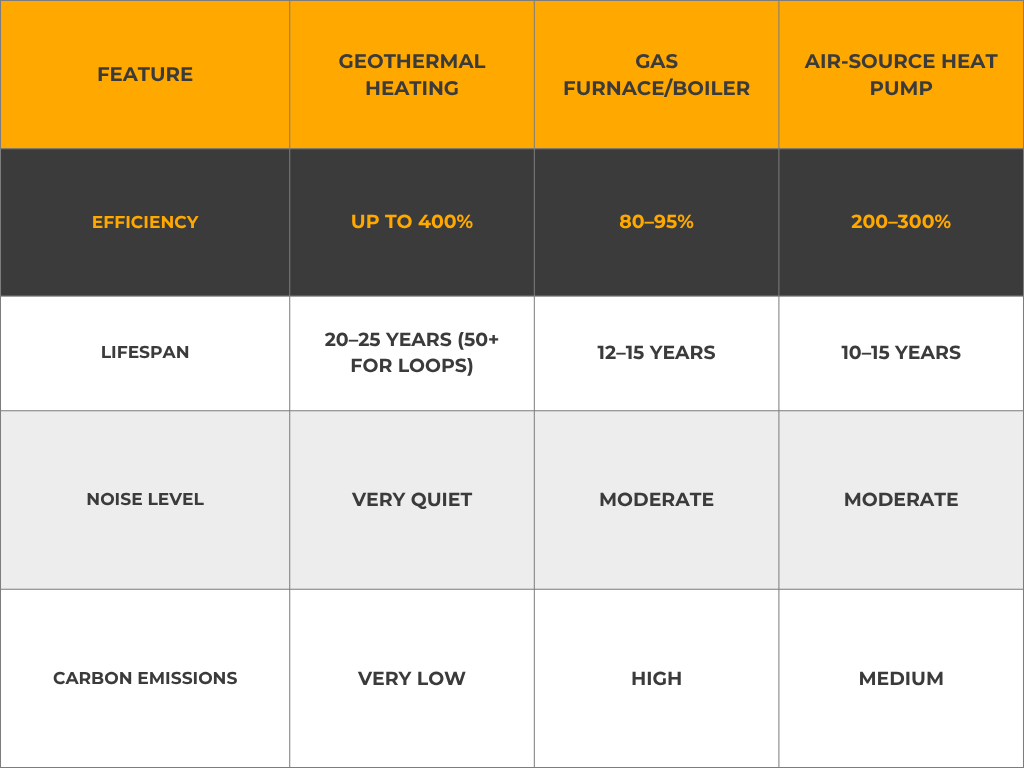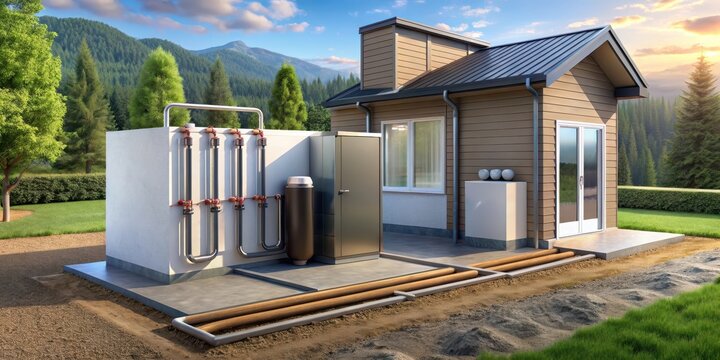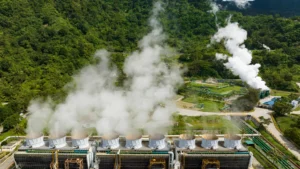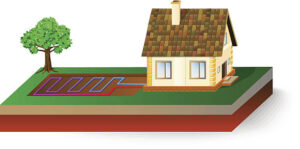When most people think about heating their homes, furnaces and boilers come to mind. But there’s a smarter, cleaner, and more efficient option available today — geothermal heating. This technology, once thought of as futuristic or only for high-end homes, is now a practical, hassle-free solution for homeowners across the country.
In this guide, we’ll break down what geothermal heating is, how it works, its benefits, costs, and why it’s one of the most sustainable choices for 2025 and beyond. By the end, you’ll understand why going geothermal could be the smartest move you make for your comfort, your wallet, and the planet.
What Is Geothermal Heating?
At its core, geothermal heating is about using the steady temperature beneath the Earth’s surface to warm your home. While outdoor air can fluctuate wildly — from freezing winters to scorching summers — the ground maintains a relatively constant temperature just a few feet below the surface.
A ground source heat pump taps into that stability, transferring heat from the earth into your home in winter and reversing the process in summer for cooling. The result? Year-round comfort from a system that’s cleaner and more efficient than traditional HVAC.
👉 Learn more here: Geothermal Heating & Cooling

How Does Geothermal Heating Work?
Understanding geothermal HVAC is simpler than you might think. Here’s the process broken down step by step:
- Underground Loops – Pipes are buried underground, either horizontally or vertically, circulating a water-based solution.
- Heat Exchange – In winter, the system absorbs heat from the ground and transfers it indoors. In summer, the cycle reverses, pushing heat from your home into the ground.
- Heat Pump Unit – Located inside your home, this unit compresses or releases heat to condition the air.
- Distribution System – Ducts or radiant floor heating distribute the comfortable air throughout your house.
This cycle makes geothermal heating one of the most versatile and sustainable HVAC options available today.
Why Choose Geothermal Heating?
Switching to geothermal heating comes with a long list of advantages, including:
- Unmatched Efficiency – Delivers up to 400% efficiency (producing 4 units of energy for every 1 unit consumed).
- Lower Operating Costs – Reduces heating and cooling bills by up to 70%.
- Eco-Friendly – Cuts carbon emissions by relying on renewable energy.
- Quiet Operation – No noisy outdoor compressors.
- Long Lifespan – Ground loops last 50+ years, heat pump units 20–25 years.
- Comfort – Consistent, even heating without hot or cold spots.
When people say geothermal heating is hassle-free, they’re talking about the minimal maintenance, long-term reliability, and low energy bills that come with it.
Geothermal Heating vs. Traditional Systems

Clearly, geothermal heating outperforms most conventional systems in efficiency, sustainability, and long-term value.
Installation Process: What to Expect
One of the concerns homeowners often have about geothermal HVAC is installation. While it is more involved upfront, it’s not as complicated as it seems.
Steps:
- Site Evaluation – Technicians assess soil type, land space, and your home’s heating/cooling needs.
- Loop Installation – Pipes are buried in horizontal trenches or vertical wells.
- Indoor Unit Setup – Heat pump is installed inside your home.
- Connection – System is tied into ductwork or radiant floor heating.
- Testing & Commissioning – Final checks ensure the system runs smoothly.
Once installed, the system requires very little upkeep compared to traditional furnaces or air conditioners.
Costs and Incentives for Geothermal Heating
A big question in any homeowner’s mind is cost. Yes, geothermal heating has a higher upfront price than traditional systems, usually between $18,000–$30,000 depending on home size and loop type.
But here’s the good news:
- Tax Credits: Federal incentives in 2025 can cover up to 30% of installation costs.
- State & Utility Rebates: Many local programs offer additional savings.
- Energy Savings: Lower utility bills can pay back the system within 5–10 years.
Over the life of the system, the financial and environmental benefits outweigh the initial investment.
Geothermal Heating for Different Home Types
- New Constructions – Perfect time to integrate geothermal loops before landscaping or building finishes.
- Existing Homes – Retrofitting is possible, especially with available land or vertical drilling.
- Rural Properties – Often easiest for loop installation due to space.
- Urban Settings – Vertical systems or pond loops can make geothermal viable.
No matter your home’s location or age, there’s likely a geothermal HVAC solution that works.

Maintenance: Truly Hassle-Free
Unlike furnaces and AC units that require frequent repairs, geothermal heating systems are built for durability.
- Filter Changes: Same as any HVAC system, every 1–3 months.
- Loop Maintenance: Virtually none — underground pipes are sealed and long-lasting.
- Annual Inspection: Basic check by an HVAC technician ensures optimal performance.
That’s it. Truly a hassle-free heating system.
Environmental Benefits of Geothermal Heating
Choosing geothermal heating isn’t just about comfort — it’s a commitment to sustainability. Benefits include:
- Reduced greenhouse gas emissions.
- Lower reliance on fossil fuels.
- Use of renewable, consistent earth energy.
- Smaller carbon footprint for your household.
It’s one of the most impactful choices a homeowner can make for the planet.
Why 2025 Is the Best Year to Go Geothermal
Several factors make now the ideal time to explore geothermal heating:
- Expanded tax credits and rebates.
- Rising energy costs, making efficiency more valuable.
- Advanced technology for cold-climate performance.
- Growing homeowner demand for eco-friendly solutions.
With incentives and long-term savings, 2025 is the year to make the switch.
Conclusion: Geothermal Heating Made Simpl
Heating your home doesn’t have to be costly, noisy, or environmentally damaging. With geothermal heating, you get a simple, hassle-free solution that delivers unmatched efficiency, comfort, and sustainability.
From installation to operation, geothermal technology is built to last — saving you money and helping protect the planet. If you’re ready to experience the future of heating, now’s the time to take action.
👉 Learn more and get started today: Contact Envirotech Geothermal
FAQs About Geothermal Heating
1. Is geothermal heating reliable in very cold climates?
Yes. Because it uses stable underground temperatures, it works efficiently even during harsh winters.
2. How long does a geothermal system last?
The indoor unit lasts 20–25 years, while underground loops can last 50+ years.
3. Will geothermal heating raise my home’s value?
Yes. Energy-efficient and eco-friendly systems are highly attractive to buyers.
4. Can geothermal also cool my home?
Absolutely. Geothermal systems provide both heating and cooling year-round.
5. Is geothermal heating loud?
No. These systems are much quieter than traditional outdoor HVAC units.


